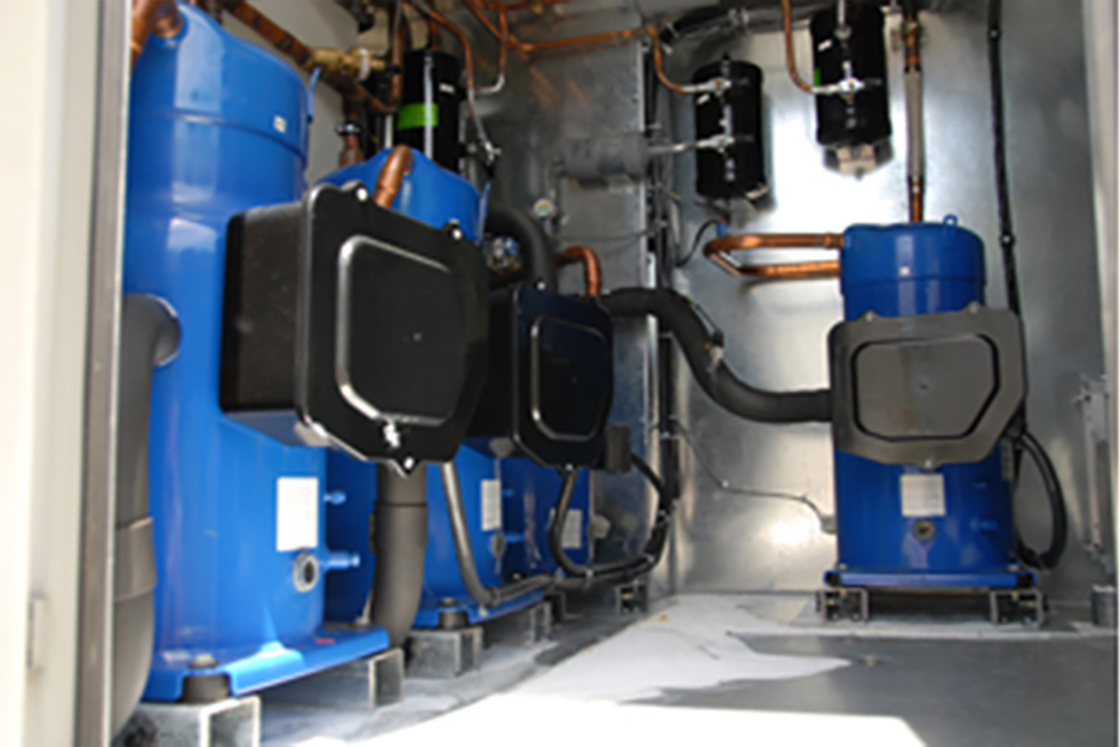"Humidity is a major issue in Williamsburg during the summer," says Mark Ballman, mechanical project manager in the college's Department of Facilities Management. "We're located between the James and York rivers and just a few miles from the Chesapeake Bay. In Yates Hall, running the existing chilled-water fan coil units didn't deal with the high humidity. In fact, condensation and mould were beginning to appear on the ceilings. "To solve the humidity problem, Ballman solicited bids for a 100 percent outside air makeup air handling system during the summer and inter-seasonal periods when humidity is uncomfortable.
Easy integration, soft start, and reduced noise

Rooftop installation inside
"We proposed two packaged DX rooftop units in our R410A- X-DRY AC Series, which utilize Danfoss Inverter compressors VSH series (one with 2x23Tons, one with 4x23Tons of cooling) designed specifically for Heat Pump and Air Conditioning," says Anthony Palucci, director of sales for Annexair.
X-DRY units combine VSH compressors and modulating gas reheat
"It's no secret that 100 percent make-up air systems using bypass hot gas reheat are costly to operate," observes Palucci. "But with the X-DRY system, we use a modulating gas reheat valve to divert only the required amount of hot refrigerant gas to the reheat coil. We also employ variable-speed condenser fans to control head pressure on the refrigerant circuit. Finally, we take advantage of the speed control of Danfoss Inverter compressors to deliver only the required cooling capacity."
VSH compressors enable system integration with all the features that make it easy to integrate into systems.
"The VSH compressor is able to reduce speed from 90 Hz to 30 Hz," says Palucci. Turndown is expressed as a ratio: in this case, 90 Hz to 30 Hz is a 3 to 1 turndown ratio. That means a single VSH compressor providing 23-ton capacity at 90Hz, the highest operating speed, can reduce capacity down to seven tons at 30 Hz, the lowest operating speed. But by using four 23-ton compressors, the Annexair MAU-2 unit can go from 84 tons to seven tons for a 12:1 turndown ratio.
The high turndown ratio helps meet the project's number one goal-dehumidification. "When a compressor can reduce capacity, it's as if the size of the cooling coils becomes thermodynamically larger," explains Palucci. "Anytime you expose the air stream to more coil surface area, you pull more water vapor out of the air."
Because about 90% of operating hours occur at part-load conditions, the turndown ratio allows compressor speed to be reduced to match lower capacity requirements. Consequently, inverter compressors can operate within +0.2F of set point. Fixed speed compressors, on the other hand, have to run at full speed and use either ON/OFF cycling or other capacity-reduction method that wastes energy. Palucci estimates that depending on ambient conditions, the X-DRY systems are 15 to 30 percent more energy-efficient than conventional fixed-speed systems.
Soft start and reduced noise are valuable side benefits
"The X-DRY systems are meeting and exceeding the specs," says Ballman. "They are designed to deliver dry air when dry bulb entering air temperatures range from 95 to 55 °F and wet bulb temperatures range from 78 to 53 °F. That's quite a range. But we've found the Annexair units are making the grade by supplying dry makeup air efficiently, reliably and quietly."
